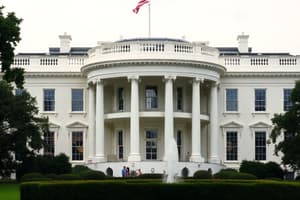Podcast
Questions and Answers
Thomas Jefferson and architect Benjamin Henry Latrobe built the East and West ______ to connect the wings with the Executive Residence.
Thomas Jefferson and architect Benjamin Henry Latrobe built the East and West ______ to connect the wings with the Executive Residence.
Colonnades
The architectural style known as ______ draws inspiration from the works of Andrea Palladio.
The architectural style known as ______ draws inspiration from the works of Andrea Palladio.
Palladianism
To prevent weather damage, the White House was originally painted ______ in 1798.
To prevent weather damage, the White House was originally painted ______ in 1798.
white
President Chester Arthur enlisted ______ to reimagine the interiors of the White House in 1882.
President Chester Arthur enlisted ______ to reimagine the interiors of the White House in 1882.
The design of the White House is ______, a feature that conveys balance, order, and stability.
The design of the White House is ______, a feature that conveys balance, order, and stability.
The White House, located in Washington, DC, is at 1600 ______ Ave.
The White House, located in Washington, DC, is at 1600 ______ Ave.
President Theodore Roosevelt officially named the building the ______ House in 1901.
President Theodore Roosevelt officially named the building the ______ House in 1901.
The architectural design of the White House was inspired by ______-style architecture.
The architectural design of the White House was inspired by ______-style architecture.
President George Washington chose the location for the capital on the ______ River.
President George Washington chose the location for the capital on the ______ River.
Irish-born architect ______ Hoban's design was selected for the White House.
Irish-born architect ______ Hoban's design was selected for the White House.
Flashcards are hidden until you start studying
Study Notes
Historical Background
- Located at 1600 Pennsylvania Ave, Washington, DC, the White House has been the residence of every U.S. president since John Adams.
- Renamed "The White House" by President Theodore Roosevelt in 1901.
- Holds significant historical importance as an iconic large-scale civil engineering project in the U.S.
Architectural Design
- Inspired by Georgian-style architecture, particularly the Leinster House in Dublin, Ireland.
- Features balance, symmetry, and proportions indicative of meticulous civil and architectural planning.
- Construction techniques include stonework and load-bearing masonry representative of late 18th-century engineering.
Modern Engineering Integration
- Despite its historical facade, the White House incorporates modern systems such as HVAC and advanced electrical and security systems, showcasing structural complexity and resilience.
Site Selection and Design Development
- President George Washington chose the Potomac River location for the capital with urban planner Pierre Charles L'Enfant.
- L'Enfant's expensive original plan for the White House was abandoned; a design competition was held, resulting in James Hoban's winning submission in 1792.
- Hoban’s design reflected classical ideals and practical needs for the executive residence.
Notable Renovations
- Significant renovations began during Thomas Jefferson's administration, including the East and West Colonnades created with architect Benjamin Henry Latrobe.
- The War of 1812 prompted the first major renovation after British forces attacked, leading to the rebuilding led by Hoban, completed in 1817.
Architectural Style and Aesthetics
- The White House exemplifies Palladian architecture inspired by Andrea Palladio, focusing on the principles of ancient antiquity as suggested by Vitruvius.
- Neoclassical elements are evident, such as grand columns and symmetry, embodying democratic ideals.
Color and Painting
- Originally painted white in 1798 to protect against weather damage, not merely to cover up fire scars from 1814.
- Currently painted in Duron's Whisper White, requiring 570 gallons of paint for the exterior.
Interior Design Evolution
- Renovations in the late 19th and early 20th centuries included Louis Comfort Tiffany's redesign of key interior spaces.
- The China Room was established during this period, contributing to the home's decorative history.
- The Kennedy administration focused on restoring historic furniture and decor, further enhancing the home's legacy.
Proportion and Symmetry
- Symmetrical design is a hallmark of neoclassical architecture, conveying balance, order, and stability throughout the White House's facade.
Studying That Suits You
Use AI to generate personalized quizzes and flashcards to suit your learning preferences.




